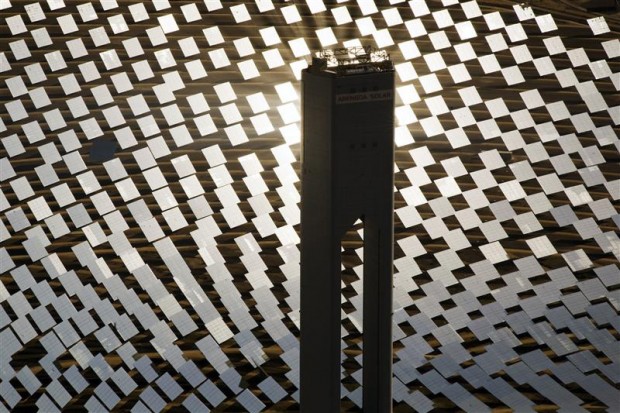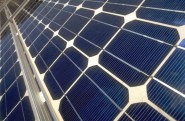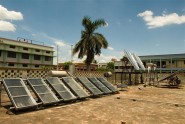In the past, solar had a reputation for being uneconomic and impractical, but this is no longer the case. Rapid advances in manufacturing techniques mean that solar is now a mature technology. It is playing an increasingly important role in the mix of clean energy sources which we need to replace our current dependence on fossil fuels.
Three main types of solar power are in regular use today: photovoltaic, solar thermal, and concentrated solar plants.
Concentrated solar plants

PS10 Concentrating solar thermal power plant in Spain. © Greenpeace / Markel Redondo.
The most exciting recent developments have been in concentrated solar plants, which have been described as “the technology that will save humanity”.
They use massed banks of parabolic mirrors to concentrate the sun’s energy on a single point and generate intense heat. This is used to super heat water, creating steam which in turn drives a turbine and generates electricity. Importantly, they don’t only work when the sun shines. Once built, they can operate well into the night.
And they’re rapidly growing in popularity. Spain has pioneered development, and has over 50 plants either built or in construction, plus hundreds more export orders from all over the world.
Because the energy density (or amount of power generated) per square mile of land for solar plants is low, at the moment they are still best suited to desert regions where land is cheap and the sun is strong. But the potential is enormous. It’s estimated that plants covering just 0.3 percent of the surface area of North Africa’s Sahara Desert could meet the whole of Europe’s electricity needs.
This is starting to happen. One of the most exciting projects now in development is a massive solar energy field planned for the Sahara. The Desertec Industrial Initiative aims to provide Europe with 15 percent of its power by 2050. Financed by a European consortium of leading companies including Deutche bank, Siemens and E.on, construction is due to start within the next five years.
Photovoltaic cells
 Photovoltaic panel. © Greenpeace / Steve Morgan
Photovoltaic panel. © Greenpeace / Steve Morgan
Photovoltaic power is widely used in offices and homes. It uses silicon semi-conductor cells to convert sunlight directly into electricity. Photovoltaic cells (PV's) are most commonly used as roof tiles to take advantage of the light coming from the sun. This is trapped by the cell and turned into electricity.
Solar panels can either operate as a stand-alone or feed energy to a grid. They work best when in direct sunlight, but they continue to produce electricity on cloudy days.
Solar thermal

Solar thermal system at a hospital in Bihar, India. © Harikrishna Katragadda / Greenpeace
This efficient and reliable system is based on the ancient principle that water in a dark container will warm up when the sun shines on it. Solar thermal provides energy for a wide range of applications, from domestic hot water and space heating in residential and commercial buildings, to swimming pool heating, solar-assisted cooling, industrial process heat and desalination of drinking water.
Solar hot water systems have many advantages. Being fuelled by the sunlight means of course that they emit no CO2 and reduce the consumption of fossil fuels. And they lower the cost of supplying hot water, cutting utility bills.
Solar in the UK
Whether solar ever really becomes a major energy source here in Britain is uncertain – we are already well supplied with enough potential wind, wave, tidal and hydroelectric resources for solar not to have gained much ground. As a result Britain lags behind the US, China and most of Europe in making use of large-scale solar power.
But there is certainly enough sunlight in the UK (we get about 60 percent of the sunlight received at the equator) to make investing in solar worthwhile – a point demonstrated by the fact that Britain’s first concentrated solar plant is now due to be built near St Ives in Cornwall.
Solar power in your home
Solar is also becoming a popular choice for lowering heating costs and cutting carbon emissions for many British households.
Most common are solar water heating collectors, which can provide over half a family’s yearly hot water requirements. Given that emissions from domestic homes are the third largest contributor to Britain’s CO2 output, the more of us that invest in them, the better for everyone.
Short-sightedly, the government has decided to cut grants for installing energy-saving solar technology in the home by suspending its Low Carbon Buildings Programme, but it is still running a Feed-in-Tariff scheme which allows householders to sell any surplus electricity generated in their home back to the national grid.


